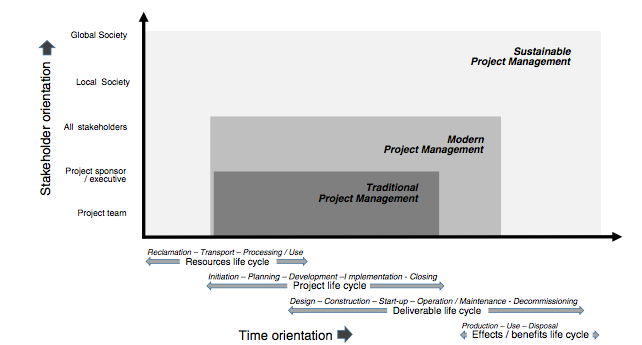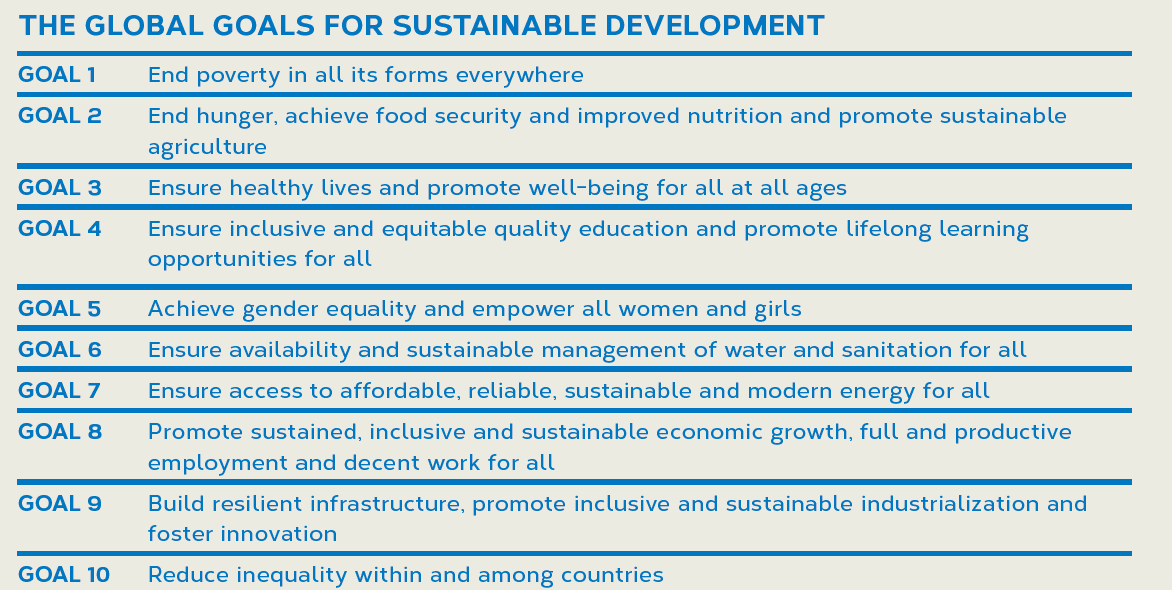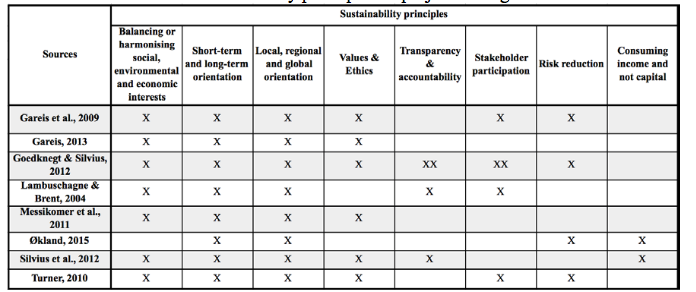
Sustainability Project Management (SPM) PART 2
Sustainable development as a function of organizational excellence results in a rather complex equation. This paper only presents some ideas for the ongoing debate.
Please click here to read PART 1.
2. 2 Requirements of sustainable development
Sustainable development as a function of organizational excellence results in a rather complex equation. This paper only presents some ideas for the ongoing debate. The intention is to translate the requirements of critical global processes to areas of organizational concern.
The two principal stakeholders are defined as humanity and nature. The report Limits to Growth lists five critical elements which are industrialization, food production, population, pollution and consumption of non‐renewable natural resources (Meadows et al., 1972).
The target level for the wellbeing of nature is a subject for ongoing debate and is not dealt with here. However, even if the level of limits for the five elements can be debated it is reasonable to say that all elements have limits that, for organizations, means to minimize pollution, the consumption of non‐renewable natural resources and the destruction of arable land. Assuming a stable natural environment human well‐being depends on food and industrial production and their distribution. Population growth puts pressure on industrial and food production.
There is a risk with the approaching limits that global per capita GNP and per capita food production will decrease as a consequence of a growing population (Traine, 1997). On the other hand there is evidence that population growth decreases when per capita GNP increases (Martin, 2000). Population growth also directly threatens nature by converting natural areas into agricultural use. Furthermore, population growth leads to increased pollution (WCED, 1987).
Poverty is not primarily a problem of global production but a problem of unequal distribution (Ackerman et al., 2000). This indicates unequal distribution as one of the primary causes threatening global sustainability. Measuring poverty is not complicated but measuring its causes is Causes for pollution are relatively easy to measure objectively but causes for poverty are subject to political debate, which complicates the issue. There is a need to have measurement tools equivalent to those on the ecological side such as life cycle analysis (LCA).
Tools like economic LCA and systems for poverty aspects and impacts might exist but they do not seem to be in common use. Lack of relevant and accepted measures constitutes a problem for the societal equity in the triple bottom line.
2.3 Project management and Sustainable development
The link among sustainability and project management is being growing discussed in researches. It’s argued that project management has a very important functions in integrating sustainability in businesses, society and projects. Moreover project management play a critical role to make a contribution to sustainable management practices. This research paper aims to improve expertise of ways which the project managers take into account sustainability in their tasks, through analyzing the consideration of sustainability aspects in their decisions (Silvius et al., 2017).
The social and ecological confrontations that existed right know in our regular daily existence, wherever around the world are the confirmation that sustainability became the steadiest theme for every one of us in the next century. It’s important for governments around the worlds, citizens, leaders, entrepreneurs, investors, et al. And Sustainability concept is especially valid for project managers.
Mangers have limited scope for adopting sustainability into the projects. However, recently we can argue that there is increasing in the sustainability awareness principles.
Carvalho & Rabechini (2017), in their study under name “Can project sustainability management impact project success? An empirical study applying a contingent approach” which aimed to validate model framework on sustainability project management and inspect the correlation among sustainability project management and project success. They used a survey-based research, using structural equation modelling to validate the research model on 222 projects between eight industries and two countries. The outcomes demonstrated a low level of sense of commitments regarding social and condition parts of the tested project. The model demonstrated a critical and positive correlation between project sustainability administration and task achievement and in diminishing the social and ecological negative effect.
We can recognition that the present methods for abusing the plant’s resources to achieve our objectives are not rational or wise, thus we should to change methods we use or modify our objective to be more sustainable (Carvalho & Rabechini, 2017).
Sustainability concept and activities should be adopted in project management procedures to push every project action meets the current requirements of stakeholders while sustaining and developing the plant resources that will be necessaries requirements in the future specially during this days the project management approach faces a paradigm shift from a mathematical approach to develop planning, infrastructure and production processes it progressing into a tool to lead and manage the organisationals.
This flourishing attention of the concerning sustainability between project Management is encouraging, however, it additionally bears challenges one of the most important challenges is; how the managers concerning projects programs think about sustainability of their operational terms and day to day activities (Silvius, 2017).
Figure 2 illustrates the extended focus of project management, so much consequences beyond thinking about sustainability within a visible example as indicates a period axis.
Stretching from the project life cycle to ‘next generations’

Figure 2: The enlarged scope of sustainable project management (Silvius, 2017).
The above emerged important questions every project manager should ask himself; How to create and execute projects that ensure achieving project objective with maximum environmental and societal protections? And what are the practical guide lines which can be integrated sustainability concept in the projects?
Ever project base on human pillars whom the team members and their leader, thus the individuals with qualities, skills, experiences, and personal values are the step stone of any project. To adopt Sustainability concept to different activities and roles in projects, we should start from individuals by inspiring them to embrace personal values in terms of ethics, social responsibility and accountability
Most of the sustainable development issues are related to Project management activities which will be increasingly affect the ability to live normally in our ecosystem as companies consume energy and natural resources to produce greenhouse gases and toxic materials that highly affect the environment. In addition, Business projects activities could influence the diversity of some species directly (e.g., forestry and agro-industry) or in directly (e.g., air/water pollution). Business projects, also, influences the environment through industrial accidents (chlorine transport accident in Pakistan, 1997).
There is a strong relation between the project management activities and sustainable development. Companies act to decease the negative impacts of business projects development and increase the positive ones. The benefits include value creation and value protection, managing costs and capturing opportunities and risks. According to “the World Business Council for Sustainable Development,” Companies should include:
- Obtaining or maintaining license to operate
- Improving the business enabling environment
- Strengthening operations and value chains
- Fuelling product and service innovation (Nelson, 2015)
Goals of Project management which can contributing to sustainable development

Figure 3: The global goals for sustainable development (Nelson, 2015)
Sustainable development is a new way for people to use resource before they’re running out; it’s the development that meets the needs of the present, without compromising the ability of future generations to meet their own needs (Sustainable development commission, n.d.). For the project management community, sustainable development is extremely important and more than a window-dressing as the companies can compete by adopting sustainable practices in order to increase both; shareholder value and their markets (BSD global, 2002). The company’s value differentiates it from its competitors; as the products and services that yield tangible results for the company’s target customers. There are two important parts of a business model which are production and marketing; the production side combines many of factors including project management activities and mechanisms for providing goods and or services. On the other hand the marketing side combines those mechanisms in order to sell the products whether it’s a good or service. The latter one is also known as capturing value but the first is known as creating value. The economic, social, environmental benefits can be delivered by the business model for sustainable development (International models for sustainable development, 2010).
According to Robert (2005), the success of the business models for sustainable development can be determined by disparate factors; trade-offs among different sustainable development goals [economic, social, environmental] need to be recognized and addressed, and the ongoing monitoring and evaluation need to be built in to the business model. The idea of sustainable development has become creating affirmation, yet it is another thought for some business executives. For most, the thought stays hypothetical and theoretical. Guaranteeing an affiliation’s capital base is a recognized business rule. The associations don’t be able to perceive the likelihood of prolongation to this idea to the world normal and HR. If sensible progression is to fulfil its potential, it must be fused into the masterminding and estimation systems of business endeavors. Besides, that to happen, the thought must be verbalized in words which are common to business pioneers (Blewitt, 2008).
According to Harry (2015), business project response was the idea of eco-effectiveness: uniting ecological and financial execution to make more regard for business itself besides, fundamentally, for the whole gathering with less impact. Numerous organizations are today all around cutting edge toward eco-capability, and it has in like manner transformed into a comprehensively recognized methodology thought supported by the European Commission. Clearly, more in business need to get eco-capability, not only the multinationals arranged in the industrialized countries furthermore little and medium endeavors in all portions in all countries.
The sustainable advancement is based on three columns: financial development, natural parity and social advancement. These things have dependably been on the maintainability motivation, however up to this point the third – the social column – has gotten less consideration. That is changing: far more noteworthy accentuation is being set now on social advancement, and particularly on what business is doing to add to this objective, and how it is conveying its commitment. This has opened up a pile of issues (Harry, 2015).
To illustrate the integration concepts between the sustainability and project management; the below table (Table 1.) Can summarized sustainability principles in project management.

Table 1: sustainability principles in project management. (Agarwal & Kalmár, 2015).
Please click here to read PART 3.



